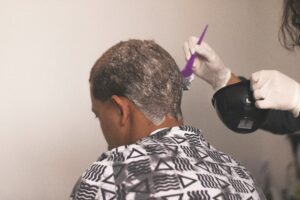Advice for a Flawless Dye Job

Embarking on a journey to transform your locks with a new hue can be exhilarating, but it’s crucial to approach the coloring process with care and consideration. Achieving that flawless dye job involves a delicate dance of creativity and caution. In this comprehensive guide, we’ll explore the dos and don’ts of hair coloring, ensuring your tresses receive the attention they deserve and the color you crave.
Dos:
- Do Consider Your Skin Tone: The first rule of successful hair coloring is to choose a shade that complements your skin tone. Cool undertones harmonize well with ashy and cool-toned colors, while warm undertones pair beautifully with golden and warm hues. Understanding your skin’s undertones is the foundation for a flattering hair color.
- Do Test the Waters with Temporary Colors: If you’re uncertain about a drastic change, opt for temporary hair colors or highlights first. This allows you to experiment with different shades without committing to a long-term change. It’s a risk-free way to gauge how a color complements your overall look.
- Do Invest in Quality Products: Quality hair dye is worth the investment. Professional-grade products not only provide better color payoff but also minimize damage to your hair. Look for reputable brands and consider consulting with a colorist for personalized recommendations.
- Do Deep Condition Before Coloring: Prep your hair by deep conditioning it a week before your dye job. Healthy, moisturized hair absorbs color more evenly, resulting in a vibrant and even finish. Regular deep conditioning treatments also fortify your strands, reducing the risk of post-coloring damage.
- Do Follow the Instructions: Each hair dye product comes with specific instructions. Follow them meticulously to ensure optimal results. Deviating from the recommended application time or mixing ratios can lead to uneven color or unexpected outcomes. Patience is key in the coloring process.
- Do Protect Your Skin and Clothing: Apply a barrier cream or petroleum jelly along your hairline and ears to prevent the dye from staining your skin. Wear old clothing or use a color cape to shield your clothes during the application process. Being proactive about protection saves you from post-coloring cleanup hassles.
- Do Strand Test for Color Accuracy: Conduct a strand test before applying color to your entire head. This small-scale test allows you to preview the color outcome and identify any potential allergic reactions. It’s a simple yet crucial step that helps you avoid surprises and achieve the desired result.
- Do Schedule Regular Touch-Ups: Keep your hair color looking fresh and vibrant by scheduling regular touch-ups. The frequency of touch-ups depends on the type of color and your hair’s growth rate. Regular maintenance ensures your color stays true to its original vibrancy.

Don’ts:
- Don’t Skip the Patch Test: Never skip the patch test, even if you’ve used the same hair dye brand before. Allergic reactions can develop over time, and it’s essential to ensure you won’t have an adverse response to the coloring agents. Apply a small amount of dye behind your ear and wait 48 hours for any signs of irritation.
- Don’t Go Drastically Dark or Light Without Consideration: A drastic change in hair color, either significantly darker or lighter, can be challenging to pull off successfully. It’s wise to consult with a professional colorist for major transformations to ensure the result aligns with your vision and enhances your overall appearance.
- Don’t Overlook Maintenance Products: Invest in color-safe shampoo and conditioner to maintain the vibrancy of your hair color. These products are formulated to preserve the integrity of the dye and minimize fading. Using regular products or harsh shampoos can strip away color and leave your hair looking lackluster.
- Don’t Apply Dye to Dirty Hair: Cleanse your hair thoroughly before applying color. Dirty or oily hair creates a barrier, preventing the color from adhering evenly. Freshly washed, dry hair provides a clean canvas for the dye, ensuring better penetration and saturation.
- Don’t Forget About Sun Protection: UV rays can cause color fading, especially in vibrant shades. Protect your newly colored locks by using hair products with built-in UV protection or wearing a hat when spending extended periods in the sun. This simple step goes a long way in preserving your hair color’s longevity.
- Don’t Rush the Rinsing Process: After the recommended development time, take your time rinsing out the color. Rushing this step can lead to incomplete removal of the dye, resulting in stains on towels and pillowcases. Thoroughly rinse until the water runs clear, and follow up with a color-safe conditioner.
- Don’t DIY Complex Techniques Without Experience: While there are many user-friendly at-home hair color kits, complex techniques such as balayage or ombre may require professional expertise. DIY attempts at intricate coloring may result in uneven or unintended outcomes. If you’re after a sophisticated look, consult with a skilled colorist.
- Don’t Ignore the Health of Your Hair: Prioritize the health of your hair over achieving a specific color. If your hair is already damaged, consider addressing its condition before diving into a drastic color change. Healthy hair not only holds color better but also looks more vibrant and feels softer.
Embarking on a hair coloring journey is a thrilling endeavor that can refresh your look and boost your confidence. By adhering to the dos and avoiding the don’ts of hair coloring, you’ll set the stage for a flawless dye job that enhances your natural beauty. Remember, the key is a thoughtful and informed approach, ensuring that your new hair color not only turns heads but also remains a testament to your individuality and style.




